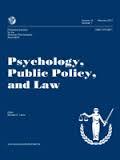
To avoid impermissible suggestion, photo arrays and lineups should be administered using double-blind procedures. This is the bottom line of a recently published article in Psychology, Public Policy, and Law. Below is a summary of the research and findings as well as a translation of this research into practice.

Featured Article | Psychology, Public Policy and Law | 2017, Vol. 23, No. 4, 421-437
The Case for Double-Blind Lineup Administration
Author
Margaret Bull Kovera, John Jay College and the Graduate Center, City University of New York
Andrew J. Evelo, John Jay College and the Graduate Center, City University of New York
Abstract
Many have recommended that lineups be conducted by administrators who do not know which lineup member is the suspect (i.e., a double-blind administration). Single-blind lineup administration, in which the administrator knows which lineup member is the suspect, increases the rate at which witnesses identify suspects, increasing the likelihood that both innocent and guilty suspects are identified. Although the increase in correct identifications of the guilty may appear desirable, in fact, this increase in correct identifications is the result of impermissible suggestion on the part of the administrator. In addition to these effects on witness choices, single-blind administration influences witness confidence through an administrator’s feedback to witnesses about their choices, reducing the correlation between witness confidence and accuracy. Finally, single-blind administration influences police reports of the witness’s identification behavior, with the same witness behavior resulting in different outcomes for suspects depending upon whether the administrator knew which lineup member was the suspect. Administrators who know which lineup member is the suspect in an identification procedure emit behaviors that increase the likelihood that witnesses will choose the suspect, primarily by causing witnesses who would have chosen a filler (known innocent member of the lineup who is not the suspect) to choose the suspect. To avoid impermissible suggestion, photo arrays and lineups should be administered using double-blind procedures.
Keywords
confidence, double-blind, eyewitness, identification, lineup administration
Summary of the Research
“Imagine a police officer administering a photo array to a witness knows which photo depicts the suspect. What expectations does that police officer hold? Perhaps the officer is extremely confident that the suspect is the perpetrator and therefore expects (a) that the witness will choose someone from the lineup, (b) that person will be the suspect, and (c) the witness will be confident in her choice. How will those expectations change the behavior of the administrator in comparison to the behavior of an administrator who does not know who the suspect is or what other evidence has been gathered against the suspect. What happens if when witnesses seem to focus on the suspect, administrators tell them to look closely or to take their time but when they focus on fillers, administrators tell them to make sure they look at all the photos. Or perhaps an administrator asks, in response to a witness who says the perpetrator is either the person in the second or third photo, asks what looks familiar about the person in the second photo, the person who happens to be the suspect. Maybe the administrator leans forward or smiles if the witness appears to linger on the suspect’s photo. Is the witness more likely to identify the suspect as a result of these behaviors? If witnesses identify suspects and the administrator praises them for identifying the suspect or merely for being good witnesses, will witnesses be more confident that they have accurately identified the perpetrator of the crime?” (p. 421).
“Concerns about the prevalence of mistaken identifications have led a number of courts to issue rulings intended to protect defendants against being mistakenly identified as a result of suggestive identification procedures. As a matter of law and when circumstances permit a lineup, administrators should not overtly identify the suspect to a witness because this is “unnecessarily suggestive.” The Supreme Court has held repeatedly that identifications obtained using suggestive procedures must be subjected to additional scrutiny to determine whether the identifications are reliable despite the suggestiveness of the procedures (e.g., a test of the totality of the circumstances). Essentially, courts are concerned with the integrity of the eyewitness evidence and the independence of the witness’s recollection of the culprit. Identifications should be based on the independent recollection of the witness and not be the result of unduly suggestive police procedures. To this end, the police routinely collect identifications from witnesses using lineups and photo arrays, which consist of a suspect-who may or may not be the culprit of the crime witnessed-and some number of known-innocent people, referred to as fillers. Fillers serve to protect innocent suspects from identification from witnesses who have poor memories of the culprit yet are willing to make a choice from the lineup anyway” (p. 421-422).
“To guard against administrators unintentionally influencing the witness to choose the suspect, eyewitness scholars began recommending as early as the late 1980s that lineups and photo arrays be conducted by administrators who do not know which person in the lineup is the suspect. The practice of blinding people to aspects of an interaction to reduce the unintentional influence of expectancies on another’s behavior is not new nor is it limited to identification procedures. Double-blind is an adjective that can modify any procedure, interaction, or experiment that may take place between two parties, when both parties (the actor and acted upon) are “blind”-that is without knowledge-about some aspect of the interaction. Double-blind procedures are common in medical experiments that test the effectiveness of a drug versus a placebo. In double-blind conditions, neither the experimenters nor the participants know if the treatment contains the active drug being tested. In a single-blind experiment, the participant does not know what treatment they are receiving but the experimenter does, and this knowledge may affect the experimenters’ behaviors, the participants’ behaviors, and the overall results of the study. For lineups, the important knowledge-the knowledge to which participants in the lineup administration must be “blinded” so that it does not affect the witness’s identification choice-is the knowledge of which lineup member is the suspect. During a double-blind lineup, neither the witness nor the administrator knows which lineup member is the suspect. During a single-blind lineup, the witness does not know which lineup member is the suspect but the administrator does” (p. 422).
Translating Research into Practice
“In addition to influencing witnesses’ identification choices, single-blind procedures allow for administrators to provide feedback to witnesses about their choices. Administrator feedback, whether explicit verbal confirmation or subtler behavioral cues, influences witnesses’ reported confidence in their identifications and their retrospective accounts of the witnessing conditions if it is provided before these reports are made. These findings underscore the importance of collecting witnesses’ confidence statements using pristine administration conditions, including double-blind procedures and instructing the witness that the administrator does not know who the suspect is. Not only will the use of double-blind procedures in combination with immediate recording of witnesses’ confidence statements protect against feedback induced confidence inflation (preserving the diagnostic value of confidence in predicting accuracy), but it will also prevent other undesirable effects of confirming feedback, including impairment of witness memory for the culprit and jurors’ ability to differentiate between accurate and inaccurate eyewitnesses who have received feedback” (p. 428).
“Even with pristine conditions, including double-blind procedures, it is quite possible that at trial, witnesses will be asked to report their confidence as well as detail their recollections of the viewing conditions during the perpetration of the crime. These retrospective accounts may be influenced by the confirmation that the suspect they identified has been indicted and is now standing trial based on their identification. Therefore, it is imperative that in addition to double-blind administration, witnesses’ accounts of the viewing conditions are preserved as soon as possible after the commission of the crime, preferably by a first responder. In addition, their confidence statements must be preserved at the time of the initial identification, before possible contamination by feedback, preferably on videotape so that the recording of the witnesses’ statements is not affected by any administrator expectation” (p. 429).
“These studies also support the idea of audio-visual recording of lineup procedures. Although there is no current evidence that recording the procedures will affect administrator influence, other studies show that law enforcement officials change their behavior when they know they are being recorded. Even if audio-visual recording does not affect administrators, the record would serve as a valuable piece of evidence for the witnesses’ actual choice and confidence as well as provide a basis for expert testimony at trial” (p. 429).
“Although these recommendations to conduct double-blind identification procedures and to make a video record of the administration are often cast as procedures that will benefit the defense, there are many ways in which these changes could benefit the prosecution and the system as a whole. Currently, when an identification results from a single-blind lineup, significant resources are consumed by defense attorneys making motions to suppress the identification and witnesses’ statements about their confidence because they may have been influenced by the administrator” (p. 429).
“When motions to suppress fail, defense attorneys often hire experts to educate the jury about the problems associated with single-blind lineup administration. Costs associated with these efforts to ameliorate the suggestiveness of the lineup procedure (e.g., court time, expert fees) disappear if the lineup is double-blind” (p. 429).
“The applied implication of these findings is that law enforcement must use administrators who are blind to the identity of the suspect to remove the potential for administrators to communicate this information to witnesses and improperly influence witnesses’ decisions. This recommendation has been recently affirmed by the Department of Justice and the National Academy of Sciences. Despite these recommendations, many jurisdictions have yet to put this procedure into practice. However, both research and theory indicate that double-blind procedures are the only way to eliminate the possibility that administrators are affecting witnesses’ decisions and accuracy” (p. 429).
“The most obvious reason for slow implementation of the double-blind procedure is that it is difficult to implement any policy over so large and complex an organization as the U.S. law enforcement system. Even if implementation were simpler, it may be that investigators are unwilling or unable to change. Law enforcement may not be aware of scientific advances made in evidence-based policing or they may not trust eyewitness researchers to recommend reforms, assuming that they often favor the defense. Top down approaches-such as state statutes that explicitly describe best practices-may be the most effective way to spur uniform policy change” (p. 429).
Other Interesting Tidbits for Researchers and Clinicians
“Double-blind lineup administration remains the least studied reform of eyewitness identification procedures (Clark, 2012a). Given the state of the field, there are several areas of inquiry that need further attention from researchers. First, the size of administrator-influence effects varies considerably, which has been a source of some criticism. For instance, some studies find an effect with simultaneous lineups whereas others find it with sequential. Thus, there is a need for the development of a theory that predicts moderators of administrator knowledge and research to test the sufficiency of that theory” (p. 432).
“A second area of inquiry that needs more exploration is the exact nature of the expectancy held by the administrator. We have assumed thus far that the expectation held by the administrator is that the witness will pick the suspect. In line with expectancy effect theory, the expectation by the administrator must be about the witness’s behavior. However, there may be other expectations and beliefs held by the administrator that may affect administrator behaviors and witness decisions. For example, administrators may develop beliefs about how difficult a witness will find the identification task and consequently may be more likely to send suggestive cues to witnesses they believe will have difficulty identifying the suspect” (p. 432).
“A third but highly related question involves research on the exact nature of the information passed to witnesses. Depending on the expectation, the administrator may be conveying different information to the witness. Although this information may take many different forms, researchers have focused on two specific possibilities: information that the culprit is in the lineup or information about which photo is the suspect. Undoubtedly, there is an asymmetric crossover relation between these two forms of information; information about which lineup member is the suspect will imply to the witness that the culprit is in the lineup but information that the culprit is in the lineup does not imply which lineup member is the suspect” (p. 433).
“We have also recommended that in addition to conducting double-blind lineups that officers video record all identification procedures so that there is physical evidence of whether the administrator engaged in any behavior that might have influenced the witness to choose the suspect or that would provide confirming feedback to the witness about the “correctness” of their choice. In practice, even identification procedures that were intended to be double-blind have been eventually contaminated by nonblind administrators entering the room before the identification procedure is complete. Having a video of the identification can preserve the record if this type of contamination occurs. We have little data about whether evaluators of these video records can spot suggestive behavior or confirming feedback. In one study, mock jurors were more likely to believe witnesses whom they saw receive confirming feedback but in another, mock jurors were able to recognize the suggestiveness of single-blind lineup procedures. Although there is no evidence that speaks directly to whether judges and attorneys can recognize the suggestiveness of single-blind lineup procedures, neither judges nor attorneys were sensitive to expectancy effects created by single-blind research on gender discrimination. Thus, more data are needed to know how judges, attorneys, and jurors will evaluate video recordings of identification procedures” (p. 433).
“Finally, to increase the adoption of double-blind procedures, researchers must determine the factors that increase reform efforts, with a special focus on factors that are under the control of advocates (e.g., a strong Innocence Project, cooperative initiatives with chiefs of police) versus factors that are not (e.g., publicity surrounding an innocent suspect identification, large civil suits). Additionally, researchers should determine which source of eyewitness reform is best for implementing change” (p. 433).
Join the Discussion
As always, please join the discussion below if you have thoughts or comments to add! To read the full article, click here.





















